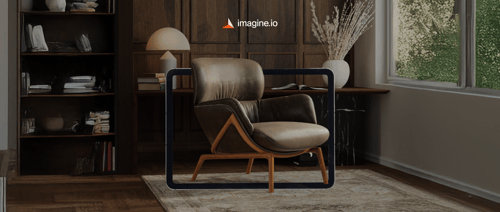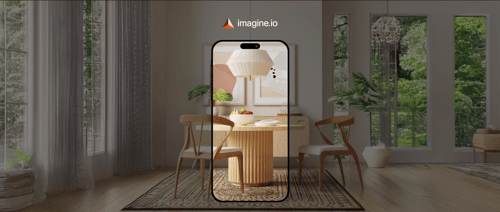In today’s digital-first commerce world, photorealism has become the baseline. If your 3D product visuals look like a real photo—great. But if that’s all they do, you’re already behind.
Modern buyers expect more than accuracy. They expect engagement, interactivity, personalization, and speed. And for businesses like yours—brands looking to scale efficiently while delivering premium visual experiences—it’s no longer about just looking real. It’s about visualizing smarter.
In this blog, we’ll go beyond surface-level realism and explore advanced techniques in 3D product visualization that leading brands are already leveraging. If you're part of a marketing, creative, or product team trying to optimize workflows, elevate shopper experience, or reduce costs, this one's for you.
Get the latest updates straight to your inbox.
By clicking sign up you'll receive occasional emails from imagine.io. You always have the choice to unsubscribe within every email you receive.
Why “Realism” Isn’t the Endgame Anymore
Let’s be honest. Realism used to be a big win in 3D. But now, with every competitor showcasing crisp renders, the differentiator isn’t just how real your product looks—but what your visuals do. True visual excellence in 2025 means:
- Speed to market
- Interactive experiences
- Visual storytelling
- Customization at scale
- Consistency across SKUs, regions, and touchpoints
You don’t just want to mimic reality—you want to enhance it. Here’s how that happens.
1. Parametric Modeling for Configurable Experiences

Today's customers want to see products in their color, size, texture—before they buy. That means your visuals need to be flexible, not fixed.
Parametric modeling allows your 3D assets to adapt in real time based on user inputs. Think of it as creating one master model that can be instantly customized into thousands of variants without having to recreate anything.
Why it matters:
- Enables product configurators and live demos
- Supports personalization without endless photoshoots
- Helps brands visualize every SKU before manufacturing
imagine.io’s configurator tools make this seamless, especially for brands managing large product lines like furniture, bedding, or appliances.
2. Physics-Based Rendering (PBR) for Material Accuracy
Photorealism relies heavily on how light interacts with surfaces. That’s where Physics-Based Rendering (PBR) comes in.
PBR simulates real-world lighting physics to recreate lifelike materials—from matte velvets to high-gloss metals—with precision. It’s a step beyond basic texture mapping.
Why it matters:
- Elevates trust in the product’s finish
- Reduces return rates due to inaccurate expectations
- Enhances realism across lighting conditions and devices
Combined with accurate material libraries and AI-generated environments, PBR can ensure that what your customers see is what they’ll actually get.
3. Lighting Intelligence for Emotional Impact
Let’s not forget: Light sets the mood. And in 3D, lighting isn't just technical—it's emotional.
Advanced 3D tools now allow teams to:
- Simulate natural daylight and indoor ambiances
- Highlight product features with strategic shadows
- Use AI to auto-adjust lighting based on context
This means you can create tailored visual stories for each campaign or shopper persona—without reshooting or re-rendering manually. Lighting intelligence is one of the unsung heroes of effective product storytelling.
4. Exploded Views & Internal Cutaways
When you want to educate, not just impress—exploded views and internal cutaways shine.

Whether you’re marketing a mattress, a home appliance, or a tech gadget, showing internal components helps convey quality, construction, and functionality.
Why it matters:
- Builds buyer confidence
- Useful for B2B sales, training, or tech-driven products
- Highlights USPs like multi-layered designs or proprietary engineering
At imagine.io, we’ve seen mattress brands reduce friction and boost sales by using exploded views to communicate premium materials and layers.
5. AI-Driven Scene Composition for Faster Go-to-Market
Here’s where things get exciting: AI can now compose entire lifestyle scenes with your 3D models—without a studio, props, or stylists. You upload your 3D asset. The platform auto-suggests room settings, lighting, angles, and even camera composition.
Benefits:
- Cuts production time from weeks to hours
- Generates multiple context shots instantly
- Keeps brand visuals consistent across campaigns
Imagine launching a new collection with contextual visuals in modern, boho, and minimalist settings—all created with a few clicks. This is already possible with AI-powered platforms like imagine.io.
6. Immersive Formats: AR, VR, and 360° Spins
We’ve gone from static product photos to immersive experiences. Advanced 3D tools can now convert your assets into:
- AR experiences (Try-before-you-buy on mobile)
- VR walk-throughs (Ideal for showrooms or retail)
- 360-degree spinners (Engaging product views on PDPs)
These aren’t gimmicks anymore. They're conversion tools.
Why it matters:
- Keeps customers engaged longer
- Reduces decision fatigue
- Creates memorable, brand-aligned experiences
In B2B and B2C alike, immersive formats are redefining visual commerce.
7. Automated Render Pipelines for Scale
If you’re working with 50+ SKUs, scalability is your biggest visual bottleneck. You need a system—not a team of artists—to deliver consistent, high-quality assets.

Enter automated render pipelines. These pipelines:
- Auto-generate visuals from data sheets
- Use rulesets for naming, lighting, and placement
- Output web-ready formats without manual edits
For enterprise brands, this is the secret to producing thousands of visuals per season—on time and within budget.
Conclusion: From Realistic to Revolutionary
The goal of 3D product visualization in 2025 is no longer just to replicate reality—it’s to elevate it. With tools like parametric modeling, AI-driven scenes, and immersive formats, brands can now create dynamic, customizable, scalable, and emotionally resonant visuals that go far beyond realism.
And platforms like imagine.io are making this transformation more accessible than ever—centralizing asset creation, optimization, and deployment into one seamless workspace. If you're ready to step beyond the old limits of realism, now is the time.
Ready to elevate your product visuals? Book a demo with imagine.io and explore what your team can do when creativity, scalability, and speed come together.


.gif?width=1296&height=1296&name=Untitled%20design%20(8).gif)




.png?width=500&name=How%20to%20Add%20a%203D%20Product%20Configurator%20to%20Your%20WordPress%20Website%20(Complete%20B2B%20Guide).png)
















%20(1).png?width=500&name=Why%20Exploded%20Mattress%20Views%20Matter%20(And%20How%20to%20Generate%20Them)%20(1).png)
.png?width=500&name=Best%20Shopify%20Product%20Configurator_%20How%20to%20Choose%20the%20Right%20One%20(2).png)
.png?width=500&name=Why%20Exploded%20Mattress%20Views%20Matter%20(And%20How%20to%20Generate%20Them).png)



.png?width=500&name=Best%20Shopify%20Product%20Configurator_%20How%20to%20Choose%20the%20Right%20One%20(1).png)







.png?width=500&name=How%203D%20Rendering%20Can%20Make%20or%20Break%20Your%20Industrial%20Design%20Pitch%20(1).png)








%20with%20Digital%20Twins%20and%203D%20Visualization.png?width=500&name=Optimizing%20Your%20Digital%20Asset%20Management%20(DAM)%20with%20Digital%20Twins%20and%203D%20Visualization.png)




.png?width=500&name=Styling%20Home%20Decor%20for%202025_%20From%20Global%20Influences%20to%20Playful%20Personalization%20(1).png)
